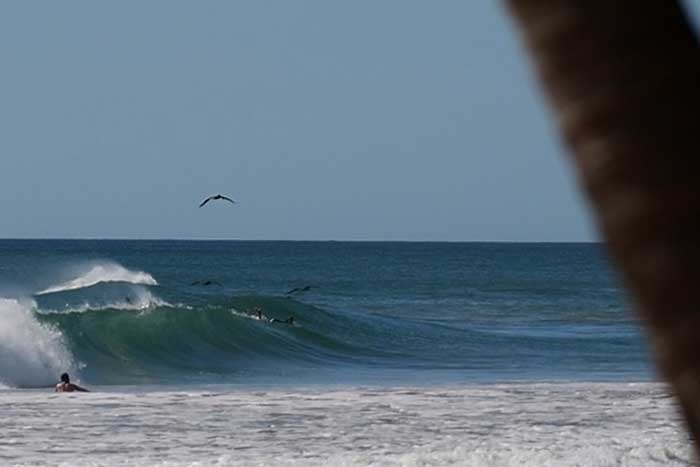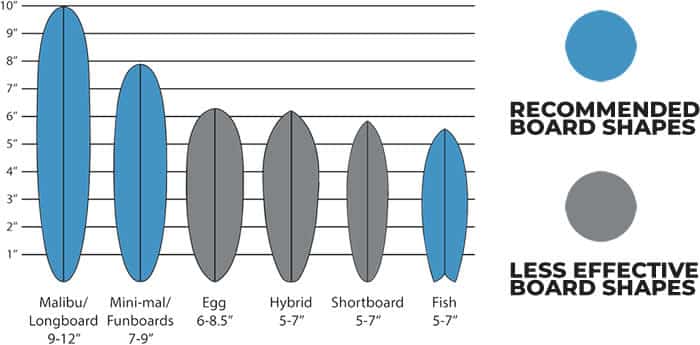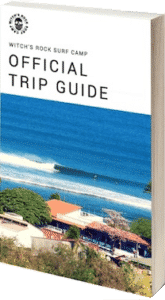
Las Palmeras - Playa Grande
Wave Quality: Average – Good (6.5 / 10)
Ideal Swell Direction: SSW (185 – 205)
Ideal Wave Height: Waist high – head high
Best Wind Direction: Light offshore
Best Tide: Mid – high
Required Experience: Intermediate- advanced
Best Board: Longboard, funboard, fish, shortboard
Bottom: Sandy
Crowd: Light
Wave Power: (6.5 / 10)
Best time of the year: July – August and December – April
Las Palmeras - Playa Grande
Location – The Las Palmeras surf break is located within the Las Baulas National Park and can be found at the northern end of Playa Grande, about 200 meters north of the main surf peak at Playa Grande.
Las Palmeras is recognizable by a cluster of tall, shady palm trees growing on the beach right in front of the surf spot. From the Tamarindo beach break, Las Palmeras is about 2.5 km to the north.
Wave Type / Quality – Left & Right Beach break (6.5 / 10) Average – Good
Las Palmeras along Playa Grande’s coastline receives more swell energy than Tamarindo on Southerly swells. Although not as big at the main peak, you can generally find rideable, powerful waves with decent shape. There are a few closeouts to deal with, but you can always pick off some lined-up waves and rides up to 100 meters with a much smaller crowd.
The same outside rocks that cross up the waves at the main peak will send an offshooting wedge through the line up at Las Palmeras offering the occasional A-frame peak and tube section. The wave is not as peaky as the main break; generally quick running lines.
Ideal Swell Direction – SSW (185 – 205)
All of the surf spots in Playa Grande will receive any swell with a southerly direction (180 – 230), but the ideal angle for wave shape Las Palmeras is about the same at the main peak (in the SSW direction).

Ideal Wave Height – Waist – head high
Similar to the main peak, Las Palmeras works best with a medium sized swell in the waist – head high range. Granted, when Las Palmeras is head high, the main peak in Playa Grande is generally well overhead. Less energy makes it to Palmeras as most of the southerly energy is refracted towards the main peak. In the waist to head high range, the wave has the best shape with less closeouts.
Best Wind Direction – Light offshore
Best wind is light – moderate offshore which can range from NNE to NE to ENE. Playa Grande actually has a huge advantage over many other spots to the south because the wind will stay offshore longer. Since Playa Grande is located closer to Lake Nicaragua, the wind will stay offshore here all day while many spots to the south turn onshore around 10am. During the dry season (Dec – April) the offshore winds can be quite strong but the waves generally remain groomed.
Rubber? – Yes (December – April)
Bring some rubber especially if the winds have been blowing offshore for several days. Although rare, water temps can drop down to about 63°F. This is a phenomenon called upwelling. Normally, water temps hover in the 75° – 80°F range. Upwelling really only happens a few times during the dry season. A wetsuit top generally comes in handy for dawn patrol sessions year round.
Best Time To Score? (December – April and July – August)
Although the SSW swells are not super consistent in the dry season (Dec – April) the conditions are perfect and you can generally surf everyday no matter what time the tides are. When there is an offseason SSW swell this time of the year, you can expect some fun waves practically by yourself.
July and August also made the list because these are our “mini-summer” months where we get plenty of offshore winds along with consistent SSW swell. During this time of year, all-day offshore winds are less common, but there is generally an offshore window that can last until 1pm.
Best Tide – Mid-high
Las Palmeras will start working about 3 hours after dead low and will break all the way up to dead high. There is no backwash to deal with at Las Palmeras so you can surf it all the way up to peak high tide. The wave actually turns into a powerful mid-break wave with the higher tides. The wave will break a little further out at medium tides but still offers good shape and length.

Required Experience – Intermediate
Las Palmeras is an excellent choice for an Intermediate surfer. The crowds are low as most surfers go to the main peak and the waves still offer enough shape to find quality rides with open faces
Best Board – Longboard, funboard, fish, shortboard
Las Palmeras offers just about everything. The waves are more mellow than the main peak so longboarders can find some slopey waves for top turns and cutbacks. When a nice side-wedge runs through the line-up, experienced riders can find quick tube sections and bowly peaks.

What’s On The Bottom? Sandy bottom
What’s The Crowd Like? – Light
One of the most appealing elements of surfing Las Palmeras is the light crowd factor. While there could be 50 surfers biting each other’s ankles at the main peak, Las Palmeras will remain pretty empty with only slightly smaller surf. As a high-end Beginner or Intermediate, Las Palmeras is a much better alternative with more space to move around and less agro locals.
How Powerful Is The Wave? (6.5 / 10)
As the swells march into the shore, most of the power is retained and the waves can pack a punch as they arrive to Las Palmeras.
Perfecto Meter – (6.5 / 10) (1 = Lake Michigan wind chop / 10= Kelly Slater Surf Ranch)
On an ideal day with the perfect swell angle, size, and light offshore winds, you will find lots of open, quick lines with only a few closeouts to contend with. The barrel is not so square, but almond shaped and non-threatening.
Spaghetti Arm Index – (3 / 10)
It’s possible to get caught inside on a set (especially with a longboard), but the wave itself doesn’t break all that far from the beach, especially with the higher tides.
Hazards – Beginners and flying boards. A few closeouts.
How Do I Get There?
From the Playa Tamarindo beach break, you will need to hire a boat taxi to cross the Tamarindo estuary and then walk north along Playa Grande’s horseshoe shaped beach. This is a long, arduous walk along soft sand and takes about 40 minutes. Las Palmeras is the strip of beach just north of Playa Grande’s main peak.
In a car, the drive takes about 25 minutes on paved roads. Just before you arrive to Playa Grande’s main peak, hang a right and follow the beach road to the north until you find the tall palm trees in front of Las Palmeras.
If you have access to a boat, you can get to Las Palmeras in 5 minutes after leaving the beach in Tamarindo.
Download the Trip Guide

- See why guests return year after year
- Review all of our surf packages
- Learn what a typical week at surf camp looks like
- How to get here, what to pack, when to travel, and more…
